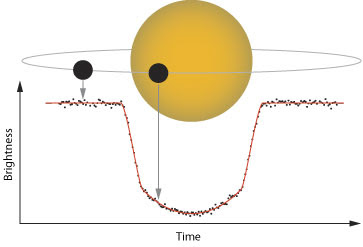
When the planet WASP-10b crosses the disk of its star, WASP-10, the brightness of the star decreases, allowing scientists to measure the precise size of the planet. John Johnson
December 11, 2008
Provided by Institute for Astronomy, Honolulu
A team of astronomers led by John Johnson of the University of Hawaii's Institute for Astronomy (UH) has used a new technique to measure the precise size of a planet orbiting a distant star. The team used a camera so sensitive that it could detect the passage of a moth in front of a lit window from a distance of 1,000 miles.
The camera, mounted on UH's 2.2-meter telescope on Mauna Kea, measures the small decrease in brightness that occurs when a planet passes in front of its star along the line-of-sight from Earth. These "planet transits" allow researchers to measure the diameters of worlds outside our solar system.
"While we know of more than 330 planets orbiting other stars in our Milky Way galaxy, we can measure the physical sizes of only the few that line up just right to transit," said Johnson. The team studied a planet called WASP-10b, which was thought to have an unusually large diameter. They measured its diameter with higher precision than before, and they found it is one of the densest planets known, rather than one of the most bloated. The planet orbits the star WASP-10, which is about 300 light-years from Earth.
Institute for Astronomy (IfA) astronomer John Tonry designed the camera, known as Orthogonal Parallel Transfer Imaging Camera (OPTIC), and it was built at the IfA. It uses a new type of detector, an orthogonal transfer array, which is the same type used in the Pan-STARRS 1.4 Gigapixel Camera, the largest digital camera in the world. These detectors are similar to the CCDs (charge-coupled devices) commonly used in scientific and consumer digital cameras, but they are more stable and can collect more light, which leads to higher precision.
"This new detector design is going to change the way we study planets. It's the killer app for planet transits," said team member Joshua Winn of Massachusetts Institute of Technology (MIT). The precision of the camera is high enough to detect transits of much smaller planets than previously possible. It measures light to a precision of one part in 2,000. For the first time, scientists are approaching the precision needed to measure transits of Earth-size planets.
Bigger planets block more of the star's surface and cause a deeper brightness dip. The diameter of WASP-10b is only 6 percent larger than that of Jupiter, even though WASP-10b is three times more massive. Correspondingly, its density is about three times higher than Jupiter's. Because their interiors become partially degenerate, Jovian planets have a nearly constant radius across a wide range of masses.
The photometric precision is three to four times higher than that of typical CCDs and two to three times higher than the best CCDs, and comparable to the most recent results from the Hubble Space Telescope for stars of the same brightness.
No comments:
Post a Comment